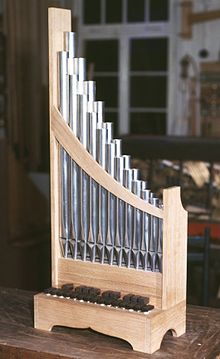
Back Портатив Bulgarian Orgue portàtil Catalan Portativ German Portativo Esperanto Órgano portátil Spanish Organo eramangarri Basque Portatiivi Finnish Orgue portatif French Portativ Croatian Organo portativo Italian


A portative organ (from the Latin verb portare, "to carry"), also known during Italian Trecento as the organetto, is a small pipe organ that consists of one rank of flue pipes, sometimes arranged in two rows, to be played while strapped to the performer at a right angle. The performer manipulates the bellows with one hand and fingers the keys with the other. The portative organ lacks a reservoir to retain a supply of wind, thus it will only produce sound while the bellows are being operated. The instrument was commonly used in European secular music from the 12th to the 16th centuries.[1]
The Italian composer Francesco Landini is known to have played the instrument. There are performers on the instrument again as a result of the Early Music Revival. Some contemporary music has been written for it, for example by José María Sánchez-Verdú.[2] Dolly Collins also used it in modern English folk music.
- ^ "Portative organ." Encyclopædia Britannica (2007). Encyclopædia Britannica Online, accessed December 23, 2007. http://www.britannica.com/eb/article-9060959.
- ^ "Guillermo Pérez". Retrieved 2019-12-09.
© MMXXIII Rich X Search. We shall prevail. All rights reserved. Rich X Search